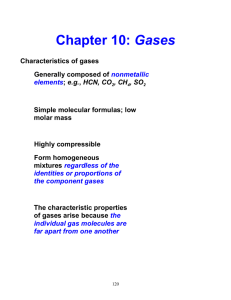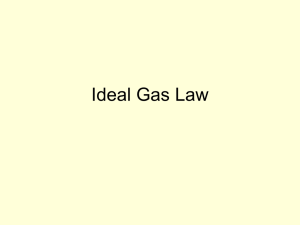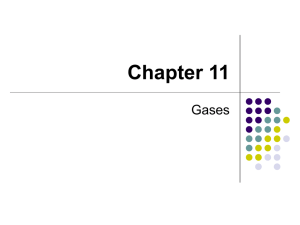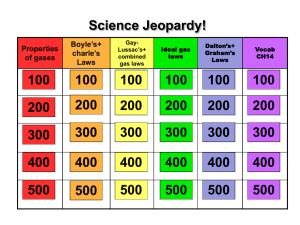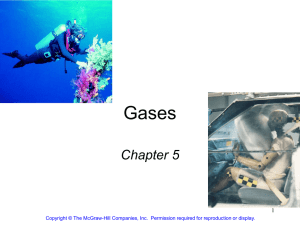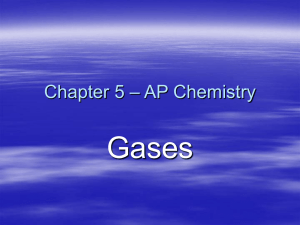The Ideal Gas Law
advertisement
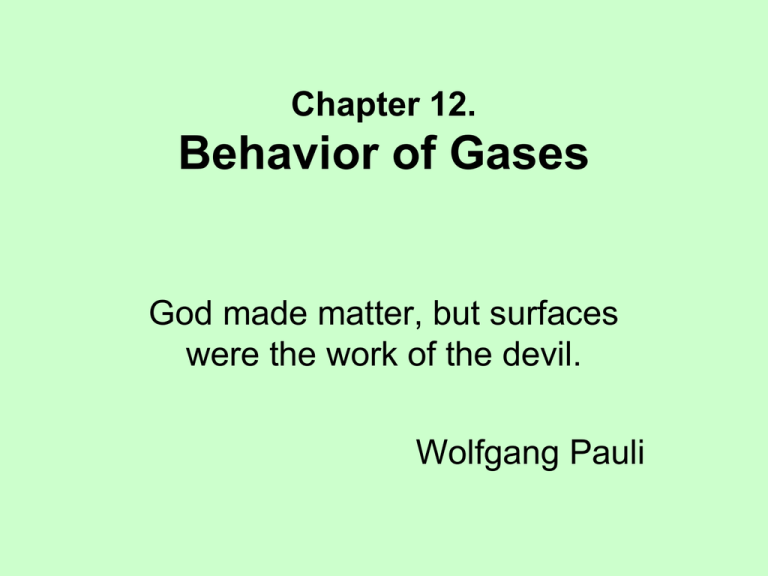
Chapter 12. Behavior of Gases God made matter, but surfaces were the work of the devil. Wolfgang Pauli Behavior of Gases Gases are substances in which intermolecular forces are quite weak, and can be overcome by the kinetic energy of the molecules. An "ideal" gas has no intermolecular forces, and the "molecules" are tiny spheres that undergo perfectly elastic collisions. Behavior of Gases The behavior of real gases can be approximated by the gas laws. The gas laws are equations that quantitatively describe behavior of certain properties of gases. Properties: Pressure, Temperature, Volume the amount of gas is constant. Pressure Pressure = Force per unit area Units of Pressure: Pounds/square inch Pascals, 1 Pa = 1 kg/(msec2) Atmospheres 1 atm = 14.7 psi, 101 kPa Millimeters of mercury 760. mm Hg, 29.9 in Hg Pressure Pressure Temperature Temperature is a measure of the hotness or coldness of a body or environment. Must be converted to Kelvins for gas law calculations. K = C + 273 There is no "below zero" or negative temperature on the Kelvin scale. Temperature Volume Volume is the space occupied by a substance, in this case a gas. Usually expressed in liters or milliliters Boyle's Law As the pressure on a gas is increased, its volume will decrease, and vice versa. P x V = constant P1 x V1 = P2 x V2 Temperature is constant Boyle's Law Boyle's Law Boyle's Law Problems: An air mattress has a volume of 114 L in the mountains, when it is put in the pickup truck. The atmospheric pressure is 0.925 atm. At the beach, the pressure is 0.975 atm. What is the volume of the air mattress at the beach? Boyle's Law Problems: An inflatable toy has a volume of 310. mL when a child takes it aboard an airliner. The atmospheric pressure is 0.995 atm. As the airliner climbs, the cabin pressure drops. The toy expands to a volume of 440. mL. What is the air pressure in the airplane? Charles' Law As the temperature of a gas is increased, its volume will increase, and vice versa. V = constant T V1 = V2 T1 T2 Pressure is constant. Charles' Law Charles' Law Charles' Law Problems: A balloon has a volume of 1.00 L while it sits in a car on a sunny day. The temperature is 25C. The night is clear and cold, and the temperature drops to 15C. What is the volume of the balloon when the air is cold? Charles' Law Problems: A sample of nitrogen gas has a volume of 675 mL at 23C. To what temperature must it be raised to increase its volume to 710. mL? Gay-Lussac's Law As the temperature of a gas is increased, its pressure will increase, and vice versa. P = constant T P1 = P2 T1 T2 Volume is constant. Gay-Lussac's Law Problems: A sample of nitrogen gas has a volume of 675 mL at 23C at 1.00 atm pressure. It is warmed to 38C (about 100F). What pressure will it reach if its container has a constant volume? The Combined Gas Law Accounts for changes in pressure, temperature, and volume simultaneously. P1V1 = P2 V2 T1 T2 The amount of gas is constant. Memorize this formula, it contains all the others. Combined Gas Law Problems: An individual has a lung capacity of 450 mL. The air in the lungs is at body temperature (37C) and 754 mm Hg. What volume would the exhaled air have on a cold winter day, with a temperature of –5C and a pressure of 750. mm Hg? Combined Gas Law Problems: A sample of argon gas occupies a volume of 80.0 mL at a pressure of 1.10 atm and a temperature of 20C. What will the temperature of the gas be, in C, if the volume of the container is decreased to 40.0 mL and the pressure is increased to 2.20 atm? …if the volume is decreased to 30.0 mL and the pressure is increased to 3.00 atm? Standard Temperature and Pressure Gases expand and contract freely with changes in temperature and pressure. Liquids and solids don’t do this. Therefore we define a standard temperature and pressure for measurement and comparison. Standard Temperature and Pressure Temperature = 0.0C, 273 K Pressure = 1.00 atm, 760. mm Hg Standard Temperature and Pressure Problems: A sample of neon gas has a volume of 23.4 L at STP. What would its volume be at 0.750 atm and –20.C? Gay-Lussac’s Law of Combining Volumes Volumes of gases that participate in chemical reactions combine in the same ratios as the coefficients for the compounds if all the gases are at the same temperature and pressure. N2(g) + 1 volume 3 H2(g) 3 volumes 2 NH3(g) 2 volumes Gay-Lussac’s Law of Combining Volumes Problems: N2(g) + 1 volume 3 H2(g) 3 volumes 2 NH3(g) 2 volumes What volume of ammonia will be formed from 60. L of H2 and excess nitrogen? What volume of nitrogen will be required to react with 60. L of H2? Avogadro’s Law Equal volumes of different gases, at the same temperature and pressure, contain equal numbers of molecules. This explained Gay-Lussac’s Law. It led to the discovery that the common gaseous elements were diatomic molecules. Avogadro’s Law The water puzzle: 4 g hydrogen + 32 g oxygen 36 g water 2 L hydrogen + 1 L oxygen 2 L water vapor 2 H2(g) + 1 O2(g) 2 H2O(g) Standard Molar Volume One mole of an ideal gas will occupy 22.414 L at STP. This is roughly 5 1/2 gallons. Conversion factors (like molar mass, g/mol) 1 mol gas 22.41 L gas 22.41 L gas 1 mol gas The Ideal Gas Law Relationship between P, V, T, and number of moles of gas. PxV T = kn P x V = k = 22.41 L x 1.00 atm nxT 1.00 mol x 273K k = 0.0821 L atm = R mol K The Ideal Gas Law Relationship between P, V, T, and number of moles of gas. PV = nRT P = Pressure in atmospheres V = Volume in liters n = number of moles of gas molecules T = temperature in Kelvins The Ideal Gas Law Problems: A portable oxygen tank holds 2.00 L at a pressure of 2000. psi. At room temperature, 25C, how many moles of gas are present? How many grams of oxygen are present? What is the density of the oxygen? The Ideal Gas Law Problems: What is the volume of 1.52 moles of carbon monoxide in a container at 0.992 atm and a temperature of 65C? The Ideal Gas Law Problems: A few milliliters of acetone are put in a vented flask that holds 100. mL. The flask is placed in a boiling water bath at 1.00 atm pressure, and the acetone vaporizes. Most of the vapor escapes, but 0.183 g remains. How many moles of acetone are present? What is its molar mass? Dalton’s Law of Partial Pressures The total pressure exerted by a mixture of gases is the sum of the partial pressures of the individual gases. The partial pressure of a gas in a mixture is the pressure it would exert if it occupied the space alone. Ptotal = p1 + p2 + p3 + … Dalton’s Law of Partial Pressures Partial pressures of gases in a mixture are proportional to the number of moles of each gas in the mixture. A mixture of 5.00 mol He, 2.00 mol O2, and 7.00 mol N2 has a pressure of 4.50 atm. What are the partial pressures of the gases? If the gases occupy a volume of 10.0 L, what is the temperature of the mixture? Dalton’s Law of Partial Pressures Collecting a Gas over Water Collecting a Gas over Water The volume of gas collected must be corrected for the partial pressure of water vapor at that temperature. The vapor pressure of water at room temperature is about 20. mm Hg, and won’t cause a substantial error. How big an error will it cause? Collecting a Gas over Water Vapor Pressure of Water as a function of Temperature 1 Vapor Pressure, Atmospheres 0.9 0.8 0.7 0.6 0.5 0.4 0.3 0.2 0.1 0 0 10 20 30 40 50 60 70 Temperature, degrees C 80 90 100
